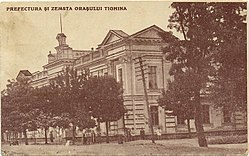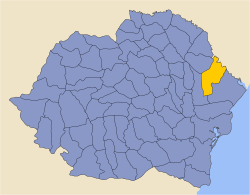|
Tighina County (Romania)
Tighina County was a county (Romanian: județ) in the Kingdom of Romania between 1925 and 1938 and between 1941 and 1944. GeographyThe county was located in the eastern part of Greater Romania, in the southeastern part of the historical region of Bessarabia, at the border with Soviet Union. At present, the territory of the former county is part of the Republic of Moldova. Tighina County was bordered to the west by Cahul County, to the north by Lăpușna County, and to the south by Cetatea-Albă County. To the east was the Soviet border on the other side of the Dniester River. Administrative organization The county was administrative subdivided into four districts (plăși):[1]
Tighina County had two urban localities:
HistoryAfter the Union of Bessarabia with Romania in 1918, the county belonged to the Kingdom of Romania, which set up the county formally in 1925. After the 1938 Administrative and Constitutional Reform, this county merged with the counties of Lăpușna, Cetatea Albă, and Orhei to form Ținutul Nistru. The area of the county was occupied by the Soviet Union in 1940 and became part of the Moldavian SSR. The area returned to Romanian administration as the Bessarabia Governorate following the Axis invasion of the Soviet Union in July 1941. A military administration was established and the region's Jewish population was either executed on the spot or deported to the Transnistria Governorate, where further numbers were killed.[2] As the Soviet Union's offensive pushed the Axis powers back, the area again was under Soviet control. On September 12, 1944, Romania signed the Moscow Armistice with the Allies. The Armistice, as well as the subsequent peace treaty of 1947, confirmed the Soviet-Romanian border as it was on January 1, 1941.[3][4] The area of the county, along with the rest of the Moldavian SSR, became part of the independent Republic of Moldova. Population According to the census data of 1930, the county's population was 306,592, of which 53.4% were ethnic Romanians, 14.7% Russians, 12.8% Gagauz, 6.4% Bulgarians, 5.5% Jews, 3.4% Germans, 3.0% Ukrainians, 0.4% Romanies, as well as other minorities. From the religious point of view, the population consisted of 89.4% Eastern Orthodox, 5.5% Jewish, 3.0% Lutherans, 0.8% Old-style Orthodox, 0.6% Roman Catholic, 0.4% Baptist, as well as other minorities.
Urban populationIn the year 1930, the county's urban population was 44,057, of which 35.6% were ethnic Russians, 19.8% Jews, 17.7% Gagauz, 16.7% Romanians, 4.4% Bulgarians, 3.1% Ukrainians, as well as other minorities. From a religious point of view, the urban population consisted of 75.1% Eastern Orthodox, 19.9% Jewish, 2.5% Old-style Orthodox, 1.0% Roman Catholic, 0.6% Lutheran, as well as other minorities. References
External linksWikimedia Commons has media related to Interwar Tighina County.

|
||||||||||||||||||||||||||||||||||||||||||||||||||||||||||||||||



